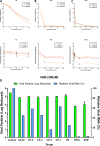Anti-SARS-CoV-2 potential of Cissampelos pareira L. identified by connectivity map-based analysis and in vitro studies
- PMID: 35459166
- PMCID: PMC9028906
- DOI: 10.1186/s12906-022-03584-3
Anti-SARS-CoV-2 potential of Cissampelos pareira L. identified by connectivity map-based analysis and in vitro studies
Abstract
Background: Viral infections have a history of abrupt and severe eruptions through the years in the form of pandemics. And yet, definitive therapies or preventive measures are not present. Herbal medicines have been a source of various antiviral compounds such as Oseltamivir, extracted using shikimic acid from star anise (Illicium verum) and Acyclovir from Carissa edulis are FDA (Food and Drug Administration) approved antiviral drugs. In this study, we dissect the anti-coronavirus infection activity of Cissampelos pareira L (Cipa) extract using an integrative approach.
Methods: We analysed the signature similarities between predicted antiviral agents and Cipa using the connectivity map ( https://clue.io/ ). Next, we tested the anti-SARS-COV-2 activity of Cipa in vitro. Molecular docking analyses of constituents of with key targets of SARS-CoV2 protein viz. spike protein, RNA‑dependent RNA‑polymerase (RdRp) and 3C‑like proteinase. was also performed. A three-way comparative analysis of Cipa transcriptome, COVID-19 BALF transcriptome and CMAP signatures of small compounds was also performed.
Results: Several predicted antivirals showed a high positive connectivity score with Cipa such as apcidin, emetine, homoharringtonine etc. We also observed 98% inhibition of SARS-COV-2 replication in infected Vero cell cultures with the whole extract. Some of its prominent pure constituents e.g. pareirarine, cissamine, magnoflorine exhibited 40-80% inhibition. Comparison of genes between BALF and Cipa showed an enrichment of biological processes like transcription regulation and response to lipids, to be downregulated in Cipa while being upregulated in COVID-19. CMAP also showed that Triciribine, torin-1 and VU-0365114-2 had positive connectivity with BALF 1 and 2, and negative connectivity with Cipa. Amongst all the tested compounds, Magnoflorine and Salutaridine exhibited the most potent and consistent strong in silico binding profiles with SARS-CoV2 therapeutic targets.
Keywords: Antivirus; BALF; COVID-19; Cissampelos pareira L.; Connectivity map; SARS-CoV-2; Whole plant extract.
© 2022. The Author(s).
Conflict of interest statement
The authors declare no conflict of statement.
Figures




Similar articles
-
Transcriptome analysis and connectivity mapping of Cissampelos pareira L. provides molecular links of ESR1 modulation to viral inhibition.Sci Rep. 2021 Oct 11;11(1):20095. doi: 10.1038/s41598-021-99444-0. Sci Rep. 2021. PMID: 34635729 Free PMC article.
-
Chemical profiling and quantification of potential active constituents responsible for the antiplasmodial activity of Cissampelos pareira.J Ethnopharmacol. 2020 Nov 15;262:113185. doi: 10.1016/j.jep.2020.113185. Epub 2020 Jul 26. J Ethnopharmacol. 2020. PMID: 32726676
-
Cissampelos pareira Linn: Natural Source of Potent Antiviral Activity against All Four Dengue Virus Serotypes.PLoS Negl Trop Dis. 2015 Dec 28;9(12):e0004255. doi: 10.1371/journal.pntd.0004255. eCollection 2015 Dec. PLoS Negl Trop Dis. 2015. PMID: 26709822 Free PMC article.
-
A Brief Overview of Potential Treatments for Viral Diseases Using Natural Plant Compounds: The Case of SARS-Cov.Molecules. 2021 Jun 24;26(13):3868. doi: 10.3390/molecules26133868. Molecules. 2021. PMID: 34202844 Free PMC article. Review.
-
Cissampelos pareira L.: A review of its traditional uses, phytochemistry, and pharmacology.J Ethnopharmacol. 2021 Jun 28;274:113850. doi: 10.1016/j.jep.2021.113850. Epub 2021 Jan 21. J Ethnopharmacol. 2021. PMID: 33485976 Review.
Cited by
-
Ayurgenomics-based frameworks in precision and integrative medicine: Translational opportunities.Camb Prism Precis Med. 2023 Jun 15;1:e29. doi: 10.1017/pcm.2023.15. eCollection 2023. Camb Prism Precis Med. 2023. PMID: 38550940 Free PMC article. Review.
-
Predicting the Anti-SARS-CoV-2 Potential of Isoquinoline Alkaloids from Brazilian Siparunaceae Species Using Chemometric Tools.Int J Mol Sci. 2025 Jan 13;26(2):633. doi: 10.3390/ijms26020633. Int J Mol Sci. 2025. PMID: 39859347 Free PMC article.
-
Synthesis, Antiacetylcholinesterase Activity, and Molecular Dynamics Simulation of Aporphine-benzylpyridinium Conjugates.ACS Med Chem Lett. 2023 Dec 8;15(1):132-142. doi: 10.1021/acsmedchemlett.3c00467. eCollection 2024 Jan 11. ACS Med Chem Lett. 2023. PMID: 38229749 Free PMC article.
-
Plants used in Ayurveda for Jwara or fever: A review of their antiviral studies.J Ayurveda Integr Med. 2025 Mar-Apr;16(2):101085. doi: 10.1016/j.jaim.2024.101085. Epub 2025 Apr 30. J Ayurveda Integr Med. 2025. PMID: 40305981 Free PMC article. Review.
References
MeSH terms
Substances
Grants and funding
LinkOut - more resources
Full Text Sources
Research Materials
Miscellaneous

